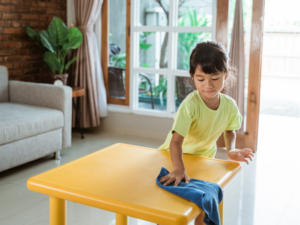Creating an environment for sensory friendly trick or treating doesn’t have to be so “tricky”. For most of us, Halloween means dressing up, trick or treating, and having parties. We might stress a little over getting the costumes our kids are asking to have, getting to the school party on time, trick or treating for the best candy, and braving the weather for trick-or-treating.
It’s all worth it, though, when we get to experience our kids’ excitement. But for children who have any kind of sensory processing disorder, Halloween can mean distress, anxiety, and meltdowns. Flashing strobe lights, uncomfortable costumes, unfamiliar homes and people, fog machines, or even loud, spooky music and sounds can be very stressful for children with sensory disorders. Some of these can be nerve-wracking for other children too.
Halloween doesn’t have to be all stressful and no fun for children with a sensory processing disorder. For example, walking around is a great way to manage the stress brought on by sensory overload. Whether you have a sensory-sensitive child or not, here are some tips for a sensory friendly trick or treating experience.
Tips for Sensory Friendly Trick Treating
- Sensory Friendly Costumes
Costumes are huge to consider when it comes to keeping sensory kids comfortable and calm on Halloween. Most pre-made costumes are made with itchy fabrics and aren’t always sewn straight, creating uncomfortable seams and overall discomfort. For some kids, it’s enough to add some soft (and preferably warm) clothing underneath. For others, it may help to create costumes out of clothes or fabrics you know they are already comfortable with.
As strange as it may seem, costumes with a little weight behind them can also help calm your sensory child. It helps them feel secure (think about a weighted blanket). It is also beneficial to avoid things like makeup, face paint, and masks. They can irritate the skin and eyes. A comfortable costume can help create a sensory friendly trick or treating experience.
- Familiar Routes
Keep to routes and houses your child is familiar with. Even walk or drive the route you plan to take ahead of time, so they know what to expect. Also, familiarize them with their costume ahead of time. If they’ve had a chance to wear it for a while, they can point out any adjustments that need to be made ahead of time, and you don’t have to worry about cutting the night short because of wardrobe issues.
- Set Expectations
Knowing what to expect is huge for helping sensory kids avoid meltdowns. Just like setting the route, it’s good to plan with your child when they want to start and stop celebrating and to determine behavior expectations. With setting time guidelines, it is good to give them a way to keep track of the time or give them substantial warnings before it’s time to wrap things up. A visual timer or picture schedule may be helpful. Knowing what to expect helps to create a sensory friendly trick or treating experience.
- Follow Your Child’s Cues
Sometimes your child will let you know they’ve had enough, but many times they are not going to realize they’ve exceeded their limits until you are facing a tantrum or meltdown. Set up a system. For example, use code words or just have an understanding that you can let the other know that it is time to wrap things up ahead of schedule. Part of a sensory friendly trick or treating experience is knowing when your child has had enough.
- Start your own traditions
Halloween movie or book marathons with Halloween-themed healthy snacks, sensory bags, and bottles are activities your child can look forward to. Carving pumpkins and getting a feel for their guts and seeds can be messy fun. You can also try making scented and colorful play dough, have a monster hunt or create a sensory bag with your pumpkin guts.
I hope these Halloween tips allow your sensory child to have a spooky, fun, and safe day!
More about Jessica
Jessica Glenbocki is a Pediatric Occupational Therapist and is certified in sensory integration and interactive metronome. She received her master’s in occupational therapy from Cleveland State University if you want more personalized ways to handle your child’s focus issues, set up a session with Jessica through her personal page on Vitalxchange to receive a more personalized plan.



